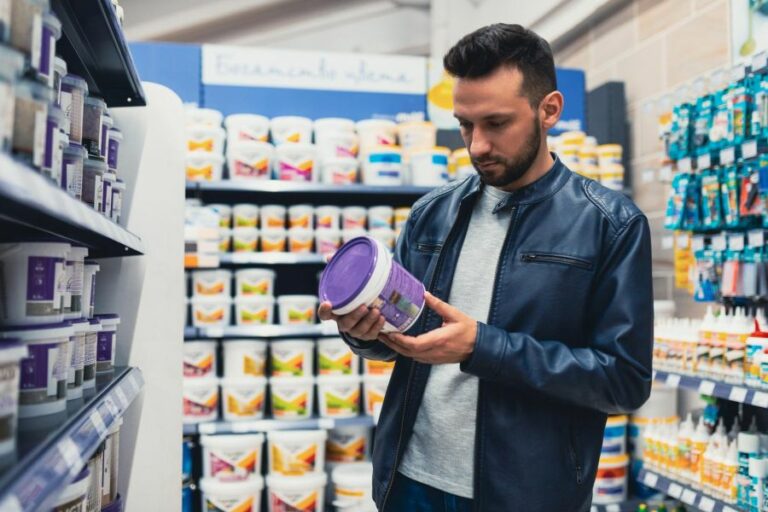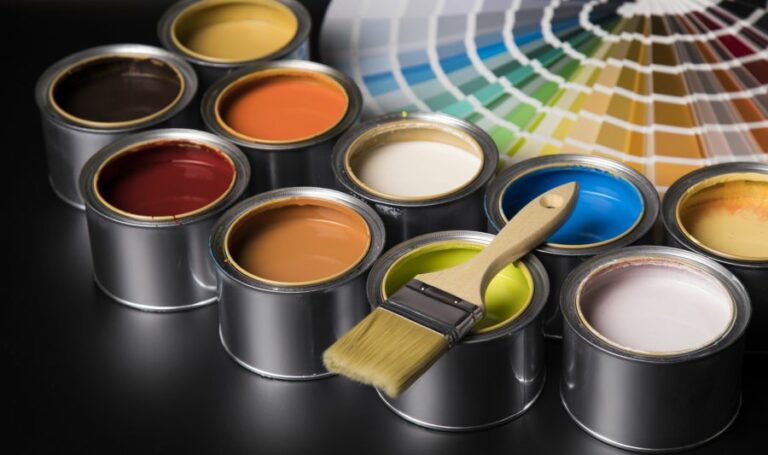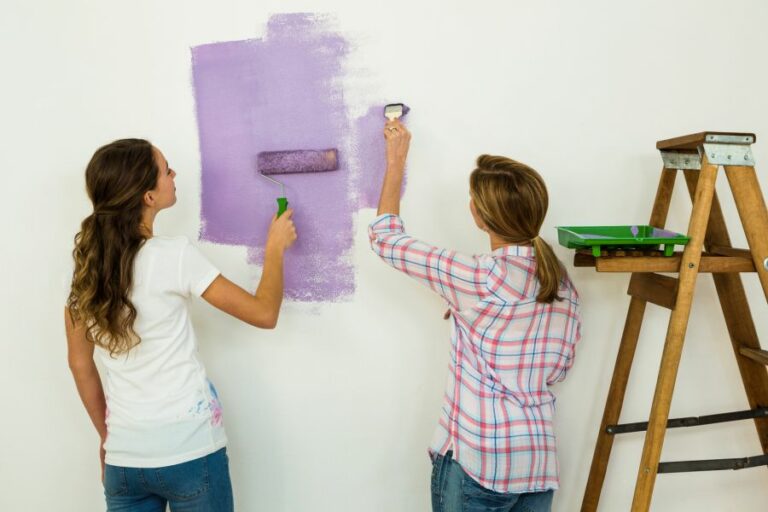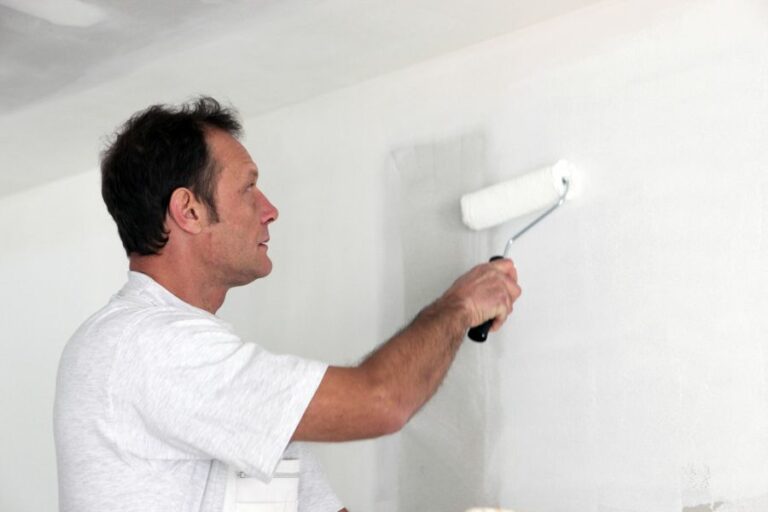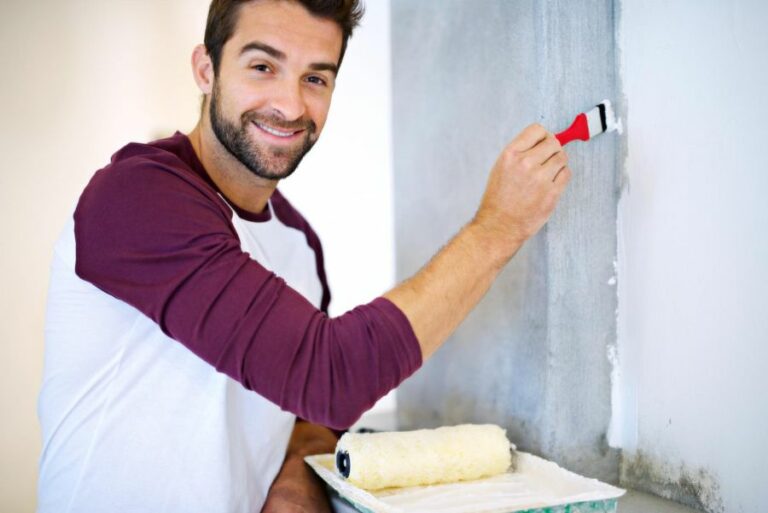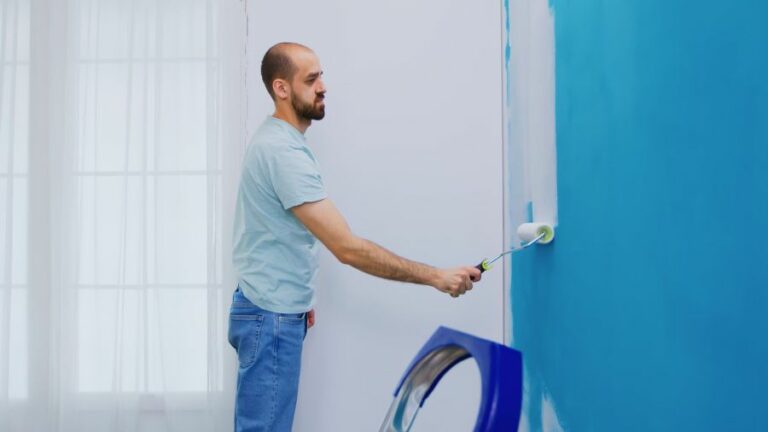Resilient Interior Paint For Moisture-Prone Areas. What Pros Say
Dealing with moisture-prone areas in your home can be challenging, but selecting the right paint type is crucial for long-lasting protection. Fret not, as I have researched for you and found the perfect resilient interior paint solution. Let’s explore the options that will efficiently withstand moisture while preserving your walls and maintaining a visually appealing appearance.
Resilient interior paint for moisture-prone areas:
Resilient interior paint for moisture-prone areas should be water-resistant, mold and mildew-resistant, easy to clean, and low-VOC. Suitable types include semi-gloss, satin, kitchen and bath, and high-gloss paint. A moisture-resistant primer should be applied before painting to enhance adhesion and prevent mold growth. Proper application techniques improve durability and protection.

Are you tired of mold and moisture wreaking havoc on your walls? If yes, then I have just the solution for you! My resilient interior paint offers superior protection against moisture in even the most damp-prone areas.
Keep reading to learn more about this innovative paint and discover how it can help you maintain a pristine, mold-free living environment.
Contents
- 1 Durable Interior Paint for High-Moisture Spaces
- 1.1 • The Importance of Choosing the Right Paint for Moisture-Prone Areas
- 1.2 • Key Features to Look for in Resilient Interior Paint
- 1.3 • Types of Resilient Interior Paints for Moisture-Prone Areas
- 1.4 • Primer: A Must for Moisture-Prone Areas
- 1.5 • Application Tips for Moisture-Prone Areas
- 1.6 • Conclusion
- 2 Top Paint Finishes for Humidity-Prone Areas
- 3 The Most Long-Lasting, Resilient Paint
- 4 Best Paint Brands for Humid Environments
- 5 Efficacy of Mold-Resistant Paint Explored
Durable Interior Paint for High-Moisture Spaces
Moisture-prone areas in your home, such as bathrooms, kitchens, and basements, can be challenging when it comes to choosing the right kind of paint. Not only do these areas require durable and long-lasting paint, but they also need paint that can withstand moisture and fluctuations in humidity levels.
• The Importance of Choosing the Right Paint for Moisture-Prone Areas
Selecting the right paint for moisture-prone areas is essential to prevent peeling, blistering, and mold growth. When moisture penetrates through the paint, it can cause it to lose its adhesion, leading to problems that require costly repairs.
Using the right paint can significantly affect the durability and effectiveness of the paint job. Plus, it can enhance the overall appearance of the treated surfaces.
• Key Features to Look for in Resilient Interior Paint
When selecting paint for moisture-prone areas, there are several key features to consider:
– Water Resistance
Water-resistant paint is crucial in these areas as it prevents moisture from penetrating the paint film. A paint that meets the ASTM D5590 standard for water resistance is an excellent choice.
– Mold and Mildew Resistance
Moisture-prone areas often harbor mold and mildew growth, which can lead to health problems for the occupants. Paints that contain mold-inhibiting additives can protect against these issues.
– Ease of Cleaning
Surfaces in moisture-prone areas tend to accumulate dirt and stains quickly. A paint with good washability is essential, making cleaning and maintaining the painted surfaces easier.
– Low-VOC
Low-VOC (Volatile Organic Compounds) paints are better for the environment and contribute to better indoor air quality.
• Types of Resilient Interior Paints for Moisture-Prone Areas
– Semi-Gloss Paint
Semi-gloss paint is a popular choice for moisture-prone areas due to its durability, water resistance, and ease of cleaning. This sheen reflects a moderate amount of light and can hide minor imperfections on the surface.
– Satin Paint
Satin paint is another suitable option for moisture-prone areas. It provides a more subtle sheen than semi-gloss paint and is easy to clean. However, it may not be as durable as semi-gloss paint.
– Kitchen and Bath Paint
Many paint manufacturers produce specific products for kitchens and baths. These paints are formulated with ingredients that resist mold, mildew, and moisture, making them ideal for moisture-prone areas.
– High-Gloss Paint
High-gloss paint is extremely durable and moisture-resistant. However, its shiny finish may highlight surface imperfections, making it less suitable for walls with uneven textures.
• Primer: A Must for Moisture-Prone Areas
Before applying paint on moisture-prone surfaces, it’s essential to prime the surface with a moisture-resistant primer. A good primer will provide a foundation for the paint, enhancing adhesion and protecting the surface from mold and mildew.
Some of the recommended primers for moisture-prone areas include:
- Oil-based primers
- Shellac-based primers
- Specialty water-resistant primers
• Application Tips for Moisture-Prone Areas
- Thoroughly clean and dry the surface before applying paint or primer
- Use a paint roller or sprayer for an even and smooth finish
- Apply at least two coats of paint for increased durability and protection
- Allow enough drying time between coats
• Conclusion
Choosing the right paint for moisture-prone areas can save homeowners time and money by reducing the need for frequent touch-ups and repairs.
Homeowners can protect their surfaces and enjoy a beautiful, long-lasting finish by selecting high-quality, resilient interior paint and following proper application techniques.
For more information about selecting the best paint for your needs, consult with an expert in your local paint store or visit a reputable source like Consumer Reports for unbiased paint reviews and advice.
Top Paint Finishes for Humidity-Prone Areas
High moisture areas, such as bathrooms, kitchens, laundry rooms, and basements, require special consideration when it comes to selecting the right paint finish. The main concern in these spaces is the presence of humidity, which can negatively impact the longevity and appearance of the paint.
In order to ensure a durable and attractive result, it is critical to choose a paint finish that is specifically designed to withstand the challenges posed by high moisture environments.
• Understanding Paint Finishes
Before delving into the best paint finish options for high moisture areas, it is essential to understand the various types of finishes available on the market.
The paint’s finish refers to the gloss or sheen level, which directly impacts the paint’s durability, cleaning capabilities, and aesthetic appeal. Common paint finishes include:
- Flat or matte finish
- Eggshell finish
- Satin finish
- Semi-gloss finish
- High-gloss finish
These finishes generally lie on a spectrum, with flat or matte finishes offering little to no sheen and high-gloss finishes offering the maximum level of sheen.
• The Top Contender: Semi-Gloss Finish
When it comes to high moisture areas, a semi-gloss finish is the best option for multiple reasons. This type of finish contains a higher amount of resin, a component that makes the paint more resistant to moisture, humidity, and overall wear and tear.
The increased durability of a semi-gloss finish ensures that it can effectively withstand the challenges posed by high moisture environments without compromising on appearance.
– Easy Cleaning and Maintenance
Semi-gloss finishes offer an additional advantage in high-moisture areas due to their ease of cleaning and maintenance. The sleek surface of a semi-gloss finish enables dirt, stains, and mildew to be easily wiped away, ensuring that the painted surfaces remain tidy and hygienic over time.
The Environmental Protection Agency (EPA) recommends regular cleaning and maintenance of surfaces in high-moisture areas to prevent the growth of mold and mildew. A semi-gloss finish makes this important task a breeze and provides added protection against the effects of humidity.
– Aesthetic Appeal
In addition to its practical benefits, a semi-gloss finish is also visually appealing. The moderate level of sheen offers a subtle shine that adds an element of elegance and sophistication to any room. This finish also effectively reflects light, making the space appear brighter and more spacious.
• Other Suitable Options: Satin and High-Gloss Finishes
While the semi-gloss finish is the top choice for high moisture areas, both satin and high-gloss finishes can also be suitable options depending on the desired aesthetic and specific needs of the space.
– Satin Finish: A Mild Sheen
A satin finish offers a lower level of sheen than a semi-gloss finish, giving it a slightly more subdued appearance.
While it contains less resin than a semi-gloss finish, a satin finish is still more resilient than flat or matte finishes and can be a suitable choice for high moisture areas with a more muted aesthetic.
– High-Gloss Finish: Maximum Sheen and Durability
For those seeking the utmost durability and maximum level of sheen, a high-gloss finish may be preferred. High-gloss finishes contain the highest amount of resin, making them extremely resistant to moisture, stains, and wear.
However, it is important to note that the reflective nature of a high-gloss finish can accentuate any imperfections on the painted surface, so thorough preparation is essential for achieving a flawless result.
• Preparing and Applying Paint in High Moisture Areas
Regardless of the chosen paint finish, proper surface preparation and application techniques are crucial for achieving a long-lasting, attractive result in high-moisture areas.
- Clean the surface: Remove dirt, stains, and mildew with a mild detergent or cleaning solution, then rinse and allow the surface to dry fully.
- Repair any damage: Fill in cracks or holes with the appropriate filler, sand smooth, and wipe away any dust.
- Prime the surface: Apply a high-quality primer, specifically designed for use in high moisture areas, to the clean and prepared surface. This will help ensure proper adhesion of the paint and prevent peeling or flaking.
- Apply the chosen paint finish: Use a high-quality paint roller or brush to apply the chosen paint finish in a uniform manner, allowing ample drying time between each coat as specified by the manufacturer.
- Ensure proper ventilation: Allow for adequate ventilation during and after the painting process to aid in drying and minimize the risk of condensation or moisture damage.
• In Conclusion
Selecting the right paint finish is critical for ensuring the longevity and appearance of any painting project in high-moisture areas. A semi-gloss finish is the top recommendation for the best combination of durability, ease of cleaning, and aesthetic appeal.
Satin and high-gloss finishes can also be suitable options, depending on the desired aesthetic and specific needs of the space. Careful preparation, application, and proper ventilation will help ensure a successful painting project that can withstand the challenges posed by high-moisture environments.
Paint Finish | Description | Benefits |
|---|---|---|
Semi-Gloss | A paint finish with a slight gloss that is less shiny than gloss paint | Resistant to moisture, mildew, and stains. Easy to clean |
High-Gloss | A paint finish with a high level of gloss, making it very shiny and reflective | Highly resistant to moisture, mildew, stains, and dirt. Easy to clean and durable |
Satin | A paint finish that has a soft, velvety sheen, sitting between a matte and semigloss finish | Resistant to moisture, mildew, and stains. Easier to clean than flat paint |
Flat or Matte | A paint finish without any gloss or sheen, making it non-reflective | Not recommended for high moisture areas due to low resistance to moisture and stains. Difficult to clean |
The Most Long-Lasting, Resilient Paint
In our quest for the perfect paint for our projects, we often look for a paint that will provide a pleasing appearance and withstand the test of time. One of the most crucial factors to consider is the durability and resilience of the paint.
• Understanding the Fundamentals of Resilient Paint
Resilient paint refers to a type of paint that can withstand harsh conditions, such as extreme weather, humidity, and other natural or man-made causes. It typically features characteristics such as superior adhesion, water resistance, and UV resistance.
– Types of Resilient Paint
There are several types of paint that can be considered resilient, and the ideal choice will depend on the specific requirements of your project. Some popular resilient paint types include:
- Acrylic-latex paint: A versatile option suitable for interior and exterior surfaces, offering excellent adhesion, water resistance, and longevity (Understanding Different Paints and How They’re Used).
- Epoxy paint: A high-performance paint that provides exceptional resistance to wear, chemicals, and abrasion, commonly used on concrete and metal surfaces.
- Polyurethane paint: A durable paint that offers a strong protective coat that is resistant to UV radiation, chemicals, and corrosion.
– Comparing the Most Resilient Paint Types
When comparing the durability of different paints, it is crucial to consider factors such as substrate compatibility, environmental resistance, and the longevity of the protective properties.
- Substrate compatibility: Some paints may not be suitable for all surface types. For example, epoxy is ideal for concrete and metal surfaces, while acrylic-latex is more versatile and can be used on wood, masonry, and other common substrates.
- Environmental resistance: Consider the conditions to which your painted surface will be exposed, such as extreme temperatures or high moisture levels. Acrylic-latex paints offer excellent resistance to water and mildew, while polyurethane paints provide better protection against UV radiation.
- Longevity of protective properties: The protective properties of resilient paints will degrade over time. Acrylic-latex paint offers long-lasting protection due to its water and UV resistance, while epoxy and polyurethane paints may require reapplication or recoating after a few years.
• Tips for Applying Resilient Paint
To ensure the resilience and durability of your paint job, follow these essential application tips.
– Surface Preparation
Proper surface preparation is key to achieving a long-lasting and resilient paint finish. Here are some steps to follow:
- Clean the surface: Remove any dirt, dust, or debris using a brush, vacuum, or pressure washer, depending on the surface and the extent of the dirt.
- Repair any defects: Fill any cracks, holes, or other imperfections with a suitable patching compound, and smoothen the surface by sanding if necessary.
- Prime the surface: Apply a high-quality primer to achieve a uniform base and ensure better adhesion of the paint (Painting Basics: Techniques & Preparation).
– Paint Selection
Choose the appropriate resilient paint according to your project’s requirements and the surface type. Consider factors such as color retention, weather resistance, and VOC content. If painting an exterior surface, choose a paint that is specifically formulated for outdoor use and offers UV resistance.
– Paint Application
Use a proper application technique and tools, such as a brush, roller, or sprayer, depending on the surface and the type of paint you are using. Apply an even coat of paint, and allow it to dry thoroughly before applying a second coat if necessary.
• Conclusion
In conclusion, the most resilient paint will ultimately depend on your specific project requirements and the environmental conditions to which the painted surface will be exposed. Acrylic-latex paint offers versatility and reliable durability, making it an excellent choice for many applications.
However, epoxy and polyurethane paints may be better suited for more specialized projects that require enhanced wear, chemical, or UV resistance.
Remember to thoroughly prepare your surface and carefully select the appropriate paint type to achieve the best possible results. Proper application techniques will also greatly contribute to the resilience and longevity of your paint job.
Best Paint Brands for Humid Environments
Climate plays a significant role in the durability and lifespan of the paint. Painting in a humid environment can be especially challenging because moisture can negatively affect the product’s adhesion and drying process, leading to issues such as blistering, peeling, and mold growth.
• Top Paint Brands for Humid Environments
1. Sherwin-Williams Duration Home Interior Acrylic Latex
Sherwin-Williams has a solid reputation for producing high-quality paints, and their Duration Home Interior Acrylic Latex paint is specifically designed to withstand humid environments.
This paint stands out due to its moisture-resistant formulation and anti-microbial properties, which inhibit the growth of mold and mildew. The product also provides excellent coverage, allowing for fewer coats, and has a quick drying time.
2. Benjamin Moore Aura Bath & Spa Interior Paint
Benjamin Moore’s Aura Bath & Spa Interior Paint is another excellent choice for humid environments, as it is specifically designed for use in high-moisture areas such as bathrooms, spas, and kitchens.
It features a unique Color Lock technology that ensures long-lasting durability and resistance to fading and is formulated to resist mildew growth. Additionally, the paint maintains a uniform color and finish, regardless of the humidity level.
3. PPG Diamond Interior Paint
PPG Diamond Interior Paint is a versatile option that performs well in humid environments. Its eco-friendly, low VOC formula promotes healthy indoor air quality, while its advanced adhesion properties ensure that the paint will not peel or blister in high-moisture areas.
This paint is also resistant to stains and scrubbing, making it easy to clean and maintain.
4. Behr Premium Plus Interior Paint and Primer in One
Behr’s Premium Plus is an excellent option for humid environments as it features a built-in moisture barrier to protect the paint from humidity-related issues.
The product also boasts a mildew-resistant finish and is GREENGUARD Gold certified, ensuring low chemical emissions for improved indoor air quality. Its paint and primer combination allows for easy application and saves time on a painting project.
5. Glidden Essentials Interior Semi-Gloss
Glidden Essentials Interior Semi-Gloss paint is a budget-friendly option that provides good performance in humid environments. This paint features a durable finish that is resistant to moisture, stains, and mildew, making it suitable for high-moisture areas.
The semi-gloss finish also adds an extra layer of protection from moisture, as it is easier to clean and maintain compared to flat or eggshell finishes.
• Tips for Painting in Humid Environments
Now that we’ve explored some of the best paint brands for humid environments let’s discuss a few helpful tips to ensure a successful paint job.
1. Proper Surface Preparation
Make sure to prepare the surface before painting adequately. This includes cleaning the surface to remove dirt, grease, and any mildew or mold and ensuring it is completely dry before applying paint. Using a primer designed for humid environments can further improve adhesion and durability.
2. Use a Dehumidifier or Fan
To create a more favorable painting environment, use a dehumidifier or fan to reduce the moisture level in the room. This can significantly speed up the drying process and minimize the risk of paint-related complications caused by humidity.
3. Time Your Painting Project Wisely
Monitor the weather forecast and try to schedule your painting project during a period of lower humidity, if possible. It is generally recommended to avoid painting when relative humidity is above 70%.
4. Allow for Adequate Drying Time
Given the potential for extended drying times in humid environments, be patient and allow ample time for the paint to dry before applying additional coats or using the newly painted space. Rushing the process can lead to paint failures such as blistering and peeling.
5. Regular Maintenance
To prolong the life of your paint job in a humid environment, it is important to check for signs of mold, mildew routinely, and any other moisture-related issues. Promptly address these problems to prevent them from getting worse and compromising the paint’s overall performance.
• Conclusion
Selecting the right paint brand for humid environments is crucial for a successful, long-lasting paint job. Brands such as Sherwin-Williams, Benjamin Moore, PPG, Behr, and Glidden all offer high-quality products specifically designed to withstand challenging atmospheric conditions, including high humidity levels.
Remember my tips to ensure an efficient and durable paint project in any humid environment.
Brand | Paint Type | Advantages |
|---|---|---|
Benjamin Moore | Aura Bath & Spa | Designed specifically for high-humidity areas, mildew resistant |
Sherwin-Williams | Duration Home | Moisture resistant, ideal for high-humid areas, easy cleanup |
Behr | Marquee | Excellent durability, resists moisture and stains, low VOC |
PPG | PermaCrete | Masonry paint ideal for humidity, alkali, and efflorescence resistant |
Zinsser | Perma-White | Excellent adhesion, mildew-resistant, durable, and washable |
Efficacy of Mold-Resistant Paint Explored
Mold-resistant paint, as the name suggests, is specifically designed to prevent the growth of mold and mildew. But does it really work?
• The Science Behind Mold Resistant Paints
Most mold-resistant paints contain fungicides or other antimicrobial agents, which actively discourage or inhibit the growth of mold spores. These chemicals work by disrupting the vital cellular processes of the mold, thus preventing it from colonizing and spreading.
Some notable ingredients in mold-resistant paints include zinc oxide, pyrithione, and silver.
In addition, high-quality mold-resistant paints are formulated to create a moisture-resistant barrier. This is important because mold relies on moisture to grow and thrive.
Therefore, by minimizing the amount of moisture that penetrates the paint’s surface, the likelihood of mold growth is also reduced.
• Factors Affecting the Efficacy of Mold Resistant Paint
While mold-resistant paints can be effective, their performance may be influenced by several factors, such as:
– Quality of the Paint
Not all mold-resistant paints are created equal. The effectiveness of antimicrobial agents can vary from one product to another. Choosing a high-quality product from a reputable manufacturer is essential to ensure the best results.
– Application Method
For mold-resistant paint to work properly, it must be applied in the correct manner. This primarily involves:
- Thoroughly cleaning and preparing the surface includes removing any mold or mildew and repairing damaged areas.
- Applying the recommended number of paint coats, typically two or more, depending on the manufacturer’s instructions.
– Environmental Conditions
The degree of mold resistance provided by paint can also be influenced by the surrounding environment.
For instance, damp, poorly ventilated spaces might see the re-emergence of mold even with a mold-resistant coating. In such cases, addressing the moisture and ventilation issues may be necessary for effective long-term mold control.
• When to Use Mold Resistant Paint
Mold-resistant paint is most effective when used in specific situations, such as:
– High-Moisture Areas
Rooms or spaces that are particularly prone to moisture, such as bathrooms, basements, and kitchens, can benefit from mold-resistant paint. These areas tend to provide ideal conditions for mold growth, and a mold-resistant coating on surfaces can help inhibit mold development.
– New Construction Projects
When constructing new buildings or undertaking extensive renovations, applying mold-resistant paint can be a proactive measure to help prevent future mold problems.
– After Mold Remediation
Employing mold-resistant paint after completing mold remediation is a wise choice to help keep mold from returning to the treated area.
• Additional Tips and Recommendations
- Thoroughly research and compare different mold-resistant paint products to choose the best one for your specific needs.
- Always follow the manufacturer’s instructions for surface preparation and paint application.
- Address any underlying moisture or ventilation problems in the area you plan to paint to maximize the paint’s effectiveness.
- Frequent cleaning and maintenance can further help prevent mold growth in high-moisture areas.
- Consider incorporating mold-resistant building materials and fixtures, such as moisture-resistant drywall, tile, and non-porous countertops, in your design or construction projects.
• In Conclusion
Mold-resistant paint can provide an effective defense against mold and mildew growth when applied correctly and in appropriate situations.
By selecting a high-quality product, following proper application methods, and addressing environmental factors that promote mold, you can help create a healthier, mold-free space in your home or workplace.

